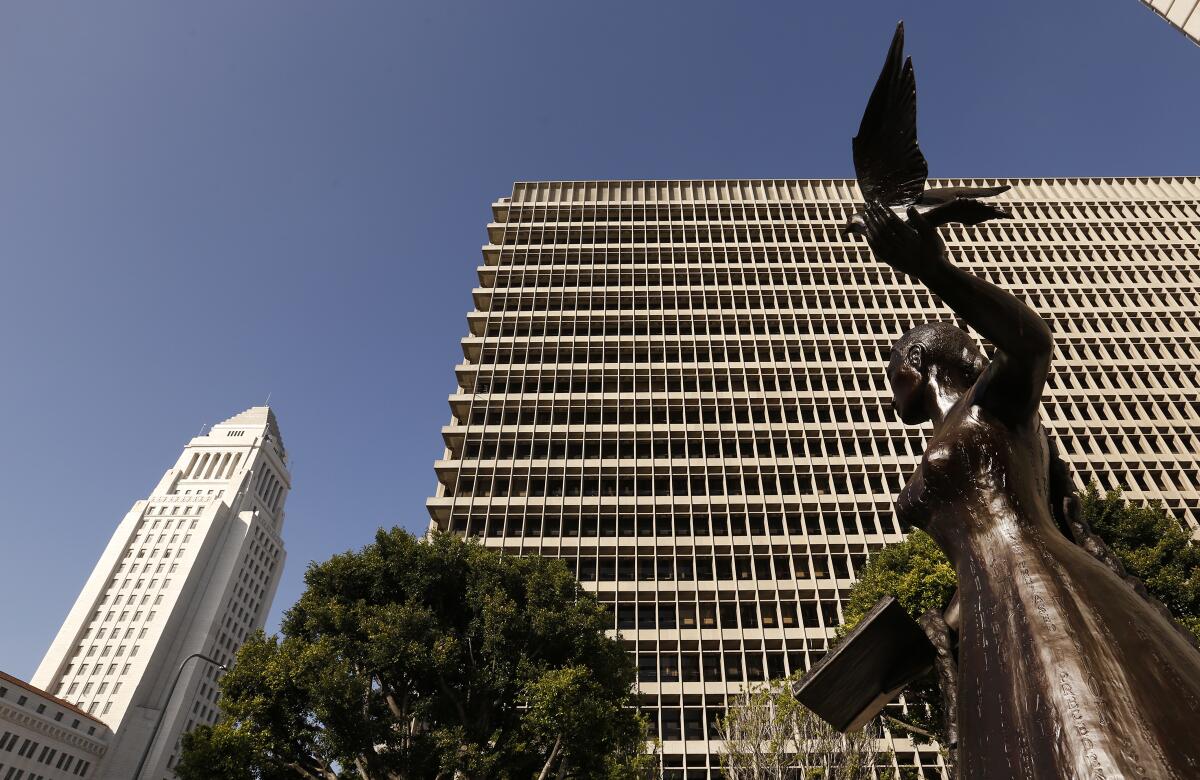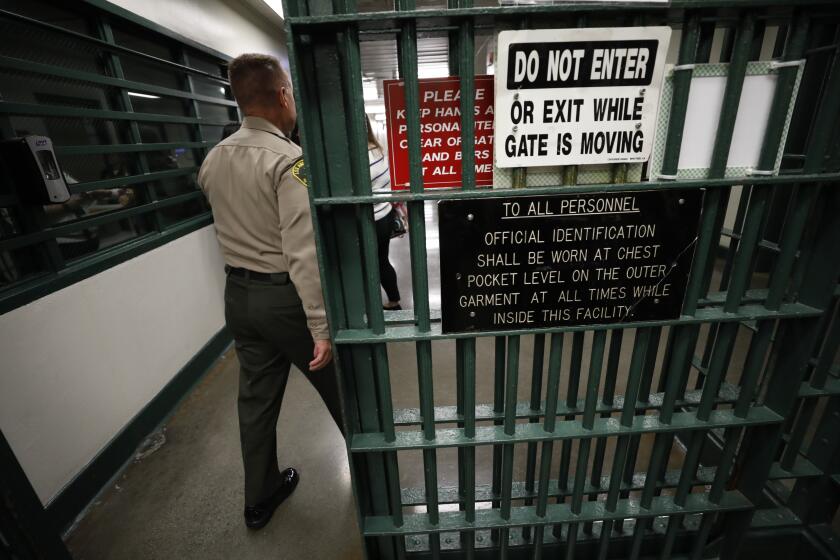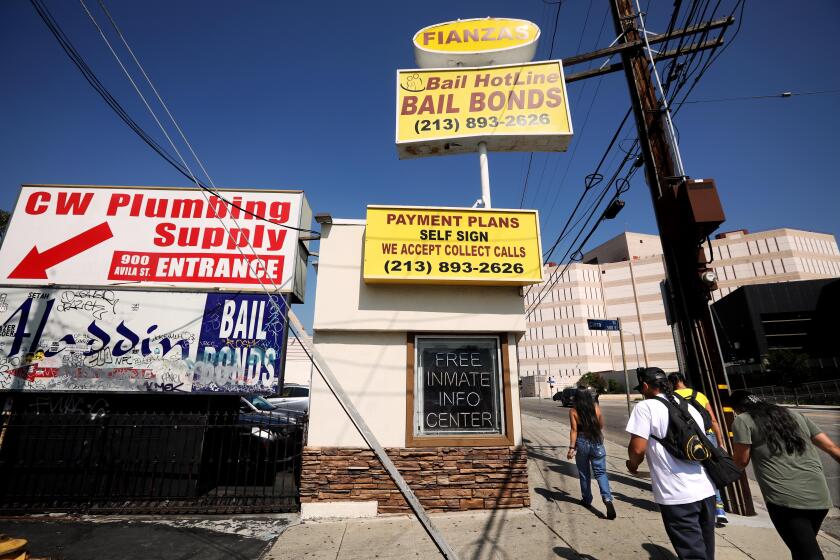Editorial: L.A. court’s refreshing candor on money bail: It doesn’t make us safer

- Share via
It was refreshing to hear Los Angeles Superior Court Presiding Judge Samantha P. Jessner’s spirited and factual defense last week of the court’s new post-arrest policy, which eliminates money bail for people accused of nonviolent and other less serious crimes.
That’s especially true in the face of the fear-based misinformation about the program currently being spread across L.A. by politicians and police.
Bail-or-jail upon arrest will largely disappear from L.A. County, correcting an injustice yet raising concerns at a time of high-profile retail thefts. First in a series.
And it’s even more welcome because the Superior Court bench, stocked with many former prosecutors, is generally considered the most conservative branch of government in L.A. on matters of public safety. The court is not known for acting precipitously.
Jessner is, herself, an-ex-prosecutor — a former assistant U.S. attorney who worked in the federal justice system, where the money bail system was essentially eliminated decades ago. So she knows what she’s talking about when she says that getting rid of bail wherever possible makes communities safer and the justice system more just.
The Los Angeles Superior Court is wiping out money bail for many crimes. Evidence shows this makes the public safer, but people who should know better are likely to offer fact-free commentary about the change.
Jessner and the court’s new executive officer, David W. Slayton, reported that less than 3% of people booked and released in the first three weeks of the court’s Pre-Arraignment Release Protocol, widely referred to as “zero bail,” were booked again for new crimes. It’s urgently important to note that almost half of those people had been released on money bail because their previous arrests were for serious or violent crimes that are not eligible for the court’s new program.
Let that sink in. Under the part of the money bail system that state laws require the court to continue using, the people who potentially pose the greatest risk to the public because of the severity of their alleged crimes get to walk free without scrutiny, if they have money.
It’s time for L.A. elected officials to defend reforms that eliminate unfair and unsafe money bail. A Superior Court program will take a step next week.
That’s the system to which the elected leaders of Santa Monica, Torrance and a dozen other cities want to return for all crimes. They filed a last-minute suit to stop the court’s program — more than two months after the court gave public notice of the change.
Why? They seem not to grasp the way the bail system works. Many police, politicians and even some prosecutors appear to believe that defendants have a financial incentive to steer clear of crime while out on bail because they’d forfeit their money if they are arrested again.
The L.A. County Superior Court is scaling back cash bail, but it was outclassed by the Illinois Supreme Court, which upheld legislation halting it altogether.
But that’s folklore, not fact. In reality, people who post the full bail amount directly with the court and then show up for trial get back every penny whether or not they are arrested again, and whether they are ultimately convicted or acquitted. And people who pay a bail bond agent a 10% fee and show up for trial won’t ever get back a single penny, regardless of any new arrests, convictions or acquittals. In either case there is no financial incentive. Bail guarantees a person’s appearance at trial, not their behavior beforehand.
And there are demonstrably more effective ways to get people to come to court than money. Los Angeles County arranges for text or email reminders, and transportation to and from the courthouse. These services improve the appearance-in-court rate far more than money bail.
Or maybe city leaders simply believe that people with money can be trusted to behave properly and people without it cannot. But if that vile and groundless presumption were true, why would the person who has money for bail have been arrested in the first place?
Going to the dentist is a pain, often literally.
In its presentation, the court wisely took note of the disturbing case of Joshua Pleasnick, a Wisconsin man who allegedly wore a handgun into the state capitol and demanded to see the governor. He was arrested on a firearms charge, posted bail and was released.
And then he returned — with an assault rifle.
If someone like Pleasnick showed up with an unlawfully displayed handgun in Los Angeles City Hall, with the Superior Court’s new protocol in effect, the arresting officer could keep him in custody for several hours while a magistrate reviewed his record and the circumstances of his arrest. There would be a fact-based determination on whether the defendant had to remain in custody until arraignment several days later. That’s not possible in a system that allows a person who has bail money to walk free, without any risk assessment or conditions.
Low-risk criminal defendants could get out of jail before trial by depositing 10% of their bail amount with the court instead of with a private bond agency, under a bill approved by the state Senate.
In fact, the chief shortcoming of the Superior Court’s protocol is not that it eliminates money bail in many cases, but that it keeps it intact for the most serious crimes because state law requires it. Changing that requirement should be near the top of state lawmakers’ to-do lists, along with rejecting the fear-and-folklore-based approach to justice and public safety.
More to Read
A cure for the common opinion
Get thought-provoking perspectives with our weekly newsletter.
You may occasionally receive promotional content from the Los Angeles Times.













